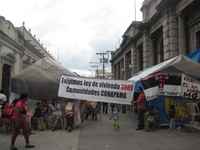Guatemala. Living on the edge of the abyss
Independent from the Occupy Movement in North-America and Europe, a movement of slum dwellers in Guatemala is occupying the street in front of Congress. They are protesting against the living conditions in the slums and a disfunctional housing policy. To change their situation they not only occupied Congress but made a bill and eventually started a hunger strike.
As crisis and poverty escalate in the Western world, activists in Europe and North America are now occupying their city squares.
In Guatemala City, however, an independent movement exists, where activists have occupied the street in front of Congress since the 22nd of August 2011. Here, warm houses were not sacrificed for tents, rather miserable hovels have been exchanged for tents. Activists from the slums have pledged not to leave until the “Housing Law” is approved – demanding a solution for the housing crisis in Guatemala. A lack of affordable accommodation forces uncountable Guatemalans into shantytowns where precarious living conditions often have lethal consequences. On the 22nd of November the law that has been fought for years once again did not receive approval. In response, three people from the camp outside Congress started a hunger strike.
THE SLUMS OF GUATEMALA
Everywhere you look there are banners in the tent-camp. The khaki-colored tents were given to the shantytowns following a natural disaster. Electricity is provided by a school in the street and plastic toilets were donated by supportive social movements. In the camp a coal fire is smoldering. The welcoming activists, mostly chatting women and their children, largely ignore the television. “The conditions here are better than where we live” they assure me.
The protesters are some of the estimated 1.5 million inhabitants of the slums of Guatemala. Shantytowns are everywhere, in cities and in the countryside. Recent accurate figures are not available. Within the camp Roly Escobar, the sympathetic representative of the organization CONAPAMG, is having a meeting with his some fellow activists. We look for a quiet place to talk. Escobar has a thorough understanding of the situation having fought for years for the rights of poor neighborhoods. Escobar claims that in Guatemala more than 800,000 families live in shacks in the 982 Guatemalan slums. Around 420 of these are situated in and around Guatemala City. According to experts a fifth to one third of the 2.5 million inhabitants of the metropolitan area reside in precarious locations.
The residents call their shantytowns “settlements”. They feel this is a more dignified and accurate description as the settlements can vary in size from a house to a whole neighborhood. “Only poor people live in the settlements, they are forced to settle on land which they do not own” says Escobar. “Often this is wasteland where nobody wants to live, on the edge of ravines, on steep slopes and adjacent to or in garbage dumps.”
After leaving the streets to live in the slums, Luis Lacán quickly became aware of the needs of the settlement dwellers and the problems they face. He joined UNASGUA – an organization that offers legal support to those who fight to improve conditions in the slums. As we sit in his humble officeLacán explains “living conditions are precarious because invariably the occupied land has nothing, no water, no electricity, no drainage, no paved streets, nothing.”
Lacán worries about his fellow slum dwellers. He explains that you cannot connect water and electricity without being able to prove a legal right to occupancy. The settlements are not included in official plans for regional and urban development and so are not considered for infrastructure investment. This sometimes has disastrous consequences for the safety and health of residents.
Over time residents often start to organize themselves, some areas acquire electricity and water, some shacks become more like houses, while others still resemble cardboard boxes. However, in spite of the age of a settlement, without legalization, the fear of eviction is ever-present.
SURVIVING IN THE SLUMS
“Most families in our neighborhoods live in houses made of rusty corrugated iron, cardboard and plastic. Some families do not even have that” says Brenda, one of the campaigners camped outside Congress. A young mother named Julia adds, “without sewage systems all the waste water from the surrounding neighborhoods passes by our shacks, shacks which have earth floors. It’s a breeding ground for diseases and infections. Our children get sick, sometimes they die, just because they lack a decent home. My daughter was eighteen months old when she became ill and died.”
Brenda nods affirmatively “during the rainy season, many people live in mud. Water flows through their shacks. Children and the elderly are particularly susceptible to pneumonia and bronchitis and deaths are not uncommon. Recently, an elderly woman died in my neighborhood from bronchitis. Because of hurricane Agatha in 2010 she lived in a house built from cardboard and plastic. My neighborhood suffered much then.”
Malnutrition has a huge impact on the health and development of the residents, especially children. According to figures from the United Nations half of Guatemalans live below the poverty line, and half the children are malnourished. These figures are the daily reality of slum dwellers. “We do not have enough money to buy food for our children. With the privatizations everything became more expensive; food, water, gas, electricity” explains Brenda indignantly. Escobar emphasizes that it is not only young children but that most settlement dwellers are malnourished. “How is this possible in such a rich country? Without work and income people will die of hunger here. This is already happening. Recently three fifteen year old teenagers died of malnutrition.”
Another common cause of death in these neighborhoods is violence. The slums are often associated with notoriously brutal gangs. Escobar, whose son was murdered, wants to put this violence in its context. “If there is no work, no schools, nothing to do, and you have the level of poverty where parents cannot afford to feed their children or send them to school then you are going to get criminality. Young people become easy prey to powerful organized criminals. These problems are not born here and do not only occur here. The whole of Guatemala is plagued by narcos and violence.”
Many inhabitants feel hopeless. Doña Rosa, an elderly woman who joins in as Brenda and Julia talk cannot restrain her tears. “What will happen if I die? Maybe I will never see this legalization.”
A LAME HOUSING POLICY AND A GROWING HOUSING PROBLEM
“Why do we go and live in a slum on the edge of an abyss or on a steep mountain slope? Not because we want to live like this, but because we hope to survive. People live here because they have no choice, there is no viable, affordable housing. Far too many people have nowhere to live” explains Brenda, whilst her five year old daughter jumps around catching her attention.
The reasons why there are so many overcrowded slums are diverse. The recent armed conflict, natural disasters, population growth and a lack of land or work in the countryside have forced many Guatemalans to migrate to the city and live in the slums.
Official figures estimate that by the end of 2011 there will be a housing shortage for 1.6 million households, of which 15% will be in Guatemala City. “The increasing demand exceeds the capacity of the State to resolve the incurred housing shortage” concludes the state institution SEGEPAZ. Those knowledgeable about the housing crisis and settlement residents agree that the government has never really tried to find a solution to the housing problem. ASIES, a research institution, found that since 1956 government action on housing has consisted of sporadic initiatives undertaken by inefficient institutions and of insufficient policy interventions, resulting in the accumulation of an enormous housing shortage.
To remedy this situation the first “Law for Housing” was finally approved in 1996. Overseen by the Ministry of Communications, Infrastructure and Housing, the new housing initiative received a ridiculously low budget. The corrupt siphoning of funds by government officials, building companies, and representatives of neighborhood organizationshas left little to provide for those with housing needs. Applying for a grant under the scheme is not only a very long and bureaucratic process, it also requires the applicant to add a considerable sum of money, something many do not have. “Given the size of the housing problem, it was clear that this law was not a solution” concludes Lacán.
The housing policy of the last few decades was mainly characterized by cosmetic solutions claims Helmer Velásquez from the newspaper El Periodico. “Residents must first occupy what is basically an uninhabitable piece of land in order to gain the attention of the authorities. After a while they are provided with “important” infrastructure such as stairs and paved allies. Especially during the elections there is thought about the conditions in the slums and about legalization.” Lacán affirms that “only during elections politicians find the way to the slums. Then they come with presents such as corrugated iron and concrete, with promises such as employment, education and health.”
FROM BILLS TO HUNGERSTRIKES
As a result of these myriad problems, shantytown residents and related social movements began working on a bill themselves, drawing on their own experiences, the Constitution, national laws and the international treaties of the United Nations which guarantee the right to housing. The University of San Carlos and relevant state institutions further refined the proposal. Lacán continues , “In 2008 the bill was presented to Congress. There too, the proposal was revised and eventually consented by Congressional committees. Since then it is stuck. The bill should only be reread and approved, in principle, a formality.”
On 23rd August 2011, when the bill was again not approved for the umpteenth time, some activists decided to set up a “Shantytown Congress”, camping in front of the doors until they are heard. “So many governments have come and gone and no one has ever taken us into account. Now we are here and we stay until they approve the bill” declares the elderly Doña Rosa combatively.
“We struggle for a law that will benefit the entire Guatemalan population” emphasizes Brenda. “We demand that shacks are changed into livable homes, that our land and our homes are legalized so we can finally connect basic services, we demand that housing is provided to families who really need it.”
Escobar wants socially responsible institutions and housing policy directed from a dedicated housing ministry. A good housing policy needs to have good law as its foundations.
Academics however point out that a law and legalization are not enough. Attention should also be paid to education, employment, living conditions, in short to a different socio-economic model which breaks the vicious circle of poverty. Otherwise, the slums will continue to grow.
But after nearly four months in front of Congress the slum dwellers begin to lose their patience. After the bill was rejected again on November 22 three residents, including the young mother Julia, decided to start a hunger strike.
If this new form of protest does not work and Congress does not approve the bill, it is likely that there will not only be further victims far away in the slums but there may also be victims in front of the door of the Representatives of the People.
(This article was first published in Dutch on 2.12.2011. On this day 7.01.2012 the activists are still in front of Congress, but stopped their hunger strike after 19 days)
www.fraukedecoodt.wordpress.com
Roly.conapamg@yahoo.com
conapamg@yahoo.com
Movimiento Guatemalteco de Pobladores
(www.movimientoguatemaltecodepobladores.blogspot.com
)

